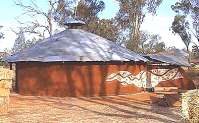Straw Bale Building in Australia, New Zealand and the rest of the World
People have been building homes using straw in many countries around the world for centuries. Reeds and straw have been used for roofing, thatching for walls and even for the ground. This material is used because it is reliable, inexpensive and easy to obtain.
 There are straw bale houses in Europe and America that are now over 100 years old and in excellent condition. These were built after the first baling machines were invented in the late 1800s which enabled straw to be formed into compact, easily managed and stored bales. At this time prairie farmers in the sand hills of Nebraska, faced with a shortage of building timber, began an intriguing method of construction using baled meadow grasses which grew in abundance.
There are straw bale houses in Europe and America that are now over 100 years old and in excellent condition. These were built after the first baling machines were invented in the late 1800s which enabled straw to be formed into compact, easily managed and stored bales. At this time prairie farmers in the sand hills of Nebraska, faced with a shortage of building timber, began an intriguing method of construction using baled meadow grasses which grew in abundance.
Straw panel houses in Australia date back to 1930's Victoria and South Australia, and 12 of those are still standing today. Read about this on Earth Garden.
In the 1980's straw bale construction was rediscovered by architect Jon Hammond who built himself a studio in northern California.
Most of the information has come from built examples (buildings over 100 years old) and by recent experimenting with different construction details. Since 1990 tests have been conducted on straw bale wall panels and individual straw bales; for flammability (fire testing), compressive strength (structural capacity) and, more recently, moisture (effects of humidity).
 The first actual straw bale building built in Australia was built by Bill Mollison in 1993 at the Permaculture Research Institute at Tyalgum in Northern NSW. This was typical of the mind of Bill who could see its potential of the sustainable future of this technology. Bill made a video on the building of this cottage, which is a bale-in-fill structure using timber ladder plates for the columns to support the roof.
The first actual straw bale building built in Australia was built by Bill Mollison in 1993 at the Permaculture Research Institute at Tyalgum in Northern NSW. This was typical of the mind of Bill who could see its potential of the sustainable future of this technology. Bill made a video on the building of this cottage, which is a bale-in-fill structure using timber ladder plates for the columns to support the roof.
Straw Bale building has a reasonably short history in Australia and New Zealand. Leo Newport from Armidale, NSW wrote the first article on straw bale building in Australia and published in Grass Roots magazine in 1995.
At the Permaculture Research Institute Peter Wade was working with Bill and took up straw bale building. They built a straw bale building on the property and it is here that straw bale building really began taking root in the Eastern Sates of Australia. Peter ran a workshop on Jo and Kerry Armstrong's property building a straw bale studio at Wolffdene near Beenleigh. This was the first Straw Bale in Queensland in 1996.
Susan Swain built the first straw bale building in Western Australia: a studio for a lead-lighter in Kalgoorlie-Boulder in November 1996 after spending a year convincing the Council that the straw bale construction was a viable alternative material. In 1996 Gary Dorn also built a number of small straw bale buildings in the Margaret River, Cunderlin, Hilton and Dowerin areas of W.A.
In 1996-7 John Glassford conducted several structural load bearing, wind loading and creep tests on straw bale walls using rice straw bales. These were the first straw bale wall tests conducted in Australia. They were conducted at the Building Research Institute of the University of New South Wales under John Carrick.
Alan Gray wrote and travelled Australia in 2000 and documented over 40 homes in the "Strawbale Homebuilding" book.
 In New Zealand around 1997 Karin and Alan Cameron started research into straw bale buildings with BRANZ and then formed a company building beautiful load bearing straw bale homes in Wanaka on the South Island. As well as the Camerons, Peter Kundyki from Wellington was also active in SB construction at this time. The Camerons built one of the first two storey straw bale buildings in the world.
In New Zealand around 1997 Karin and Alan Cameron started research into straw bale buildings with BRANZ and then formed a company building beautiful load bearing straw bale homes in Wanaka on the South Island. As well as the Camerons, Peter Kundyki from Wellington was also active in SB construction at this time. The Camerons built one of the first two storey straw bale buildings in the world.
In 2002 John Glassford set the wheels in motion to establish AUSBALE which was borne out of the 2002 International Straw Bale Building Conference at Wagga Wagga.
Many straw bale homes have been built throughout Australia and NZ, the word being spread quickly through workshops and sustainable living networks.
In this time we have learned a lot about the benefits and behaviour of straw bales in construction. Our practices have evolved as research has become available on load bearing, fire resistance and moisture movement through renders. Australian and NZ professional straw balers have become skilled in using earth, lime and cement/lime renders and are now passing these skills onto other professionals and owner-builders.

